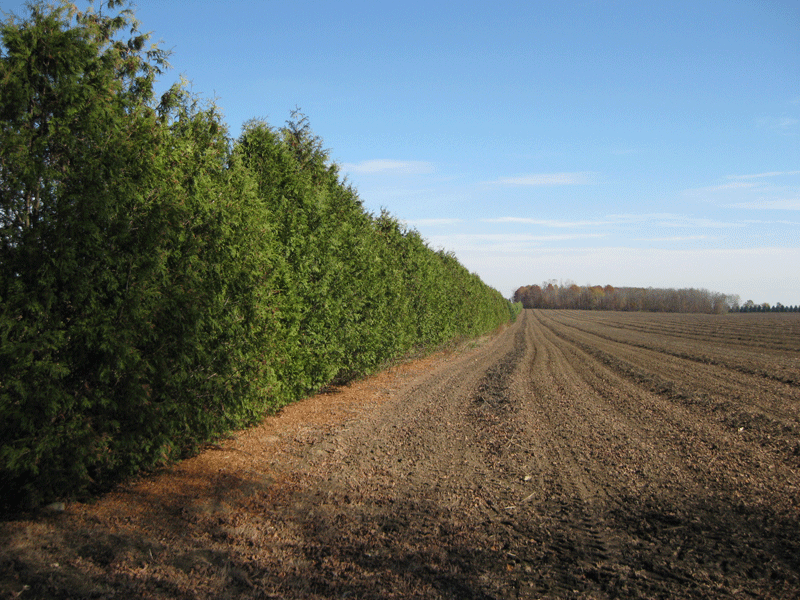Providing shelter
THE ENVIRONMENTAL BENEFITS OF WINDBREAKS
it has long been known by conservation officials that windbreaks are great tools for farmers, particularly if they’re looking to boost yields. In corn, windbreaks can result in an eight to 10 percent increase in yields. In soybeans, farmers have seen an increase of 20 to 25 percent. But higher yields aren’t their only selling point; windbreaks have also proven useful for addressing environmental issues.

John Enright is a conservation officer with the Upper Thames Conservation Authority. Part of his responsibility is to help farmers establish tree cover on their farms, that will serve multiple functions.
long-term benefits
“Over time, those windbreaks will provide control for soil erosion,” he says. “So you’re keeping your good topsoil on the field.”
Protected soil tends to warm faster in the spring too. “The soil in that area will warm up earlier, so you actually get earlier germination,” he says. “I’ve heard some farmers say that corn will germinate as many as 10 days earlier in that sheltered zone.”
Given the moisture issues that many Ontario farmers experienced in the growing season of 2012, maintaining soil moisture levels is certainly another added bonus.
“I think the fact that the plants are just sheltered,” says Enright, “That they’re not battling the constant wind all the time, so they put their energy into growth as opposed to battling the constant winds that blow across the fields.”
Interestingly, windbreaks also offer better odour control, a feature that is often of particular interest to those who raise livestock. “In recent years, we’ve done more planting, in particular with hog producers. The theory behind that is when you’re planting windbreaks around a hog farm where you’re trying to dissipate or control the odours, what we do is we plant a denser windbreak – so probably minimum two to three – and what happens is when the wind approaches a very, very dense windbreak like that the wind is actually forced up and over top of the windbreak, causing a lot of turbulence,” he explains. “And what it does is it moves the odour plume up into the atmosphere and away from the source.”
Windbreaks can also help increase insect predation by creating wildlife habitats for birds and animals. Windbreaks also offer better dust and noise control, and lower heating costs in the surrounding farm buildings.
proper planning
Ross Campbell, an Oxford County farmer who lives near Hickson, grows corn, oats, soybeans, rye and winter barley. As an organic farmer he has to have a 25-foot buffer strip around the farm, a space he’s decided to make good use of by establishing a windbreak.
Approximately seven years ago, after working through the planning stages with Enright, Campbell put in a double row of windbreaks along the south side of his farm, choosing a pattern of altering Norway spruce and European larch trees. The east side of the farm is mostly bush lot, but where it wasn’t filled in he planted larch trees. Covered predominantly by woodlot, the north side of the farm needed only a single row of alternating spruce and larch. Campbell put a few trees in where the main road passes by the west side of the farm, but not too many; instead, he put a windbreak along approximately 300 feet of his laneway.
For Campbell, the windbreak stops the snow from passing through, and instead, drops it onto the farm which provides more moisture for the soil in the spring. It helps with yields in a dry year.
“You’re going to have more snow-load out there. It protects it from excessive wind in the summertime, too. So it helps the crops,” says Campbell. “Plus, they’re awful nice to look at,” he adds.
Enright says the best varieties are Norway or white spruce, and white cedar, although the latter can suffer browse damage from deer in the winter. He warns farmers to be cautious about planting certain species, including silver maple, poplar, and willow. Because they’re water-seeking trees, they can get into tiles and cause drainage problems.
Proper planning is of the utmost importance, says Enright. “I know from my experience and planting success, a lot of it relates back to proper site preparation, so that’s why we really emphasize that the site be prepared properly before someone plants a windbreak,” he says. “In some cases, that may take a year. It may take two years.”
Beyond that, Enright suggests weed control and regular maintenance in the first three to five years to ensure success. It may also be necessary to water your newly established windbreak. If you have questions regarding the benefits of establishing a windbreak on your farm, contact your local conservation authority. •






















